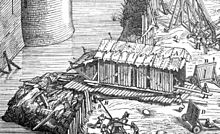Cat (siege device)
The cat was a mobile shelter that attackers used in the Middle Ages to safely approach a castle . It was made of wooden boards or wickerwork and could be open or closed on the sides. It was thus a successor to the turtles known in ancient times and the early medieval breech huts. Cats could reach considerable sizes: the shelter used by Simon de Montfort during the Albigensian Crusade at the siege of Toulouse in 1218 offered space for 400 knights and 150 archers. During sieges, cats were also used as protection for miners and sappers during mining or breaching work. They were pushed against the defensive walls of a castle so that the walls could be undermined under their protection. So that the defenders could not set the cat on fire, its roof was covered with damp sod, fresh manure or animal skins that were kept moist. In the event that a ram had such a roof, it was sometimes called a cat.
literature
- Otto Piper : Castle studies. Reprint of the 3rd edition from 1912. Weltbild, Augsburg 1994, ISBN 3-89350-554-7 , pp. 383–384.
Web links
Individual evidence
- ↑ a b Stefan Grathoff: Siege Machines , on regionalgeschichte.net ( Memento from March 5, 2017 in the Internet Archive )
- ↑ Jim Bradbury: The Medieval Siege. Boydell & Brewer, 1992, ISBN 0-85115-312-7 , p. 271 ( digitized version ).
- ^ O. Piper: Castle studies. 1994, p. 383.
